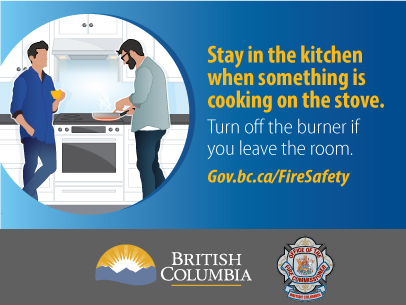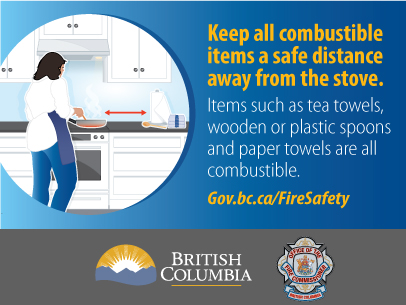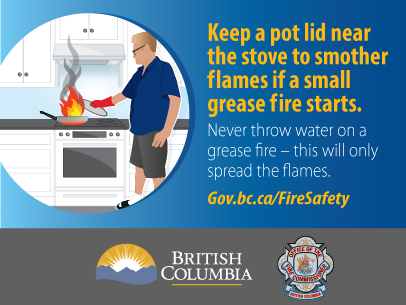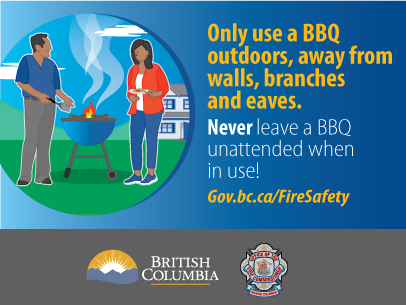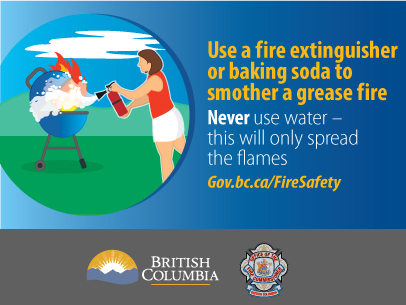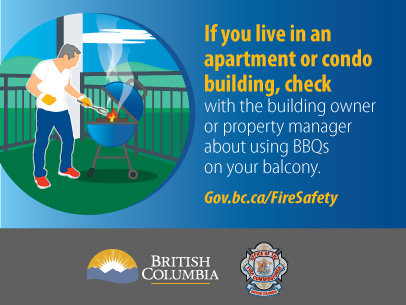Cooking and BBQing safety social media toolkit
Cooking is one of the leading cause of home fires and home fire injuries. Increase awareness in your community about the importance of cooking and BBQing safely.
Cooking in a kitchen
Social media toolkit
Messages to share
These key messages have been formatted to be used in a post. Copy and paste them, or use them to complement your own message.
- Keep an eye on what you fry. Most cooking fires start when someone is frying food
- Watch what you are cooking. Fires start when the heat is too high. If you see any smoke or the grease starts to boil, turn the burner off
- Make sure you are awake and alert while cooking. Alcohol and some drugs can make you sleepy
- Wear short sleeves or roll them up so they don’t catch on fire
- Make sure children and pets stay at least 1 metre away from a hot stove
- Turn pot handles toward the back of the stove so no one can bump them or pull them over
- Keep things that can catch fire, like oven mitts, wooden utensils, food packaging, towels, away from the stove
- Never pour water on a cooking pan grease fire! Smother the flames by sliding a lid over the pan and turn off the stove
Hashtags
#FireSafety #FirePrevention #CookingSafety #HolidayBaking
Graphics
Download and use the graphics below, either by themselves or add additional information in your post to reinforce the message.
Prevention and safety messaging
- Reduce the risk of cooking fires by being alert. You may not be fully alert if you are tired, drowsy or impaired by alcohol, cannabis, other drugs or certain medications.
- Stay in the kitchen when you are frying, grilling, or broiling food. If you leave the kitchen for even a short period of time, turn off the stove.
- If you are simmering, baking, roasting, or boiling food, check it regularly, remain in the home while food is cooking, and use a timer to remind you that you’re cooking.
- Keep things that can catch fire — potholders, oven mitts, paper or plastic bags, curtains — away from your stove top.
- Wear short, close-fitting or tightly rolled sleeves when cooking. Loose clothing can dangle onto stove burners and can catch fire if it comes in contact with a gas flame or electric burner.
- Have a “kid-free zone” of at least 1 metre around the stove and areas where hot food or drink is prepared or carried.
- Open microwaved food slowly, away from the face. Hot steam from a container of microwaved food or the food itself can cause burns.
- Never heat a baby bottle in a microwave oven because it heats liquids unevenly. Heat baby bottles in warm water.
- Treat a burn right away, putting it in cool water. Cool the burn for three to five minutes. Cover with a clean, dry cloth. If the burn is bigger than your fist, or if you have any questions, get medical help right away.
If you have a small grease or oven cooking fire:
- On the stove top, smother the flames by sliding a lid over the pan and turning off the burner. Leave the pan covered until it is completely cooled.
- Never pour water or use a fire extinguisher on a cooking pan grease fire!
- For an oven fire, turn off the heat and keep the door closed. After a fire, the oven should be checked and/or serviced before being used again.
If you have any doubt, get out!
- When you leave, close the door behind you to help contain the fire.
- Call 911 or your local emergency number from outside your home.
Grilling with a BBQ
Social media toolkit
How to use this toolkit
Share this content on social media channels. You can copy this content or customize it.
Messages to share
These key messages have been formatted to be used in a post. Copy and paste them, or use them to complement your own message.
- Never leave a hot grill unattended!
- Clean the grill's grease tray regularly to avoid it catching on fire
- Never pour water on a BBQ grease fire! Use a fire extinguisher or baking soda, or check the BBQ manufacturer's instructions
- Only use propane, charcoal and wood pellet BBQs outside. Using them indoors can cause a fire or carbon monoxide poisoning
- Only grill outdoors, away from siding and deck railings, and away from eaves and branches
- Check with your landlord, building manager or strata before using a grill on a balcony of your apartment building
Hashtags
#FireSafety #FirePrevention #BBQsafety #GrillingSafety
Graphics
Download and use the graphics below, either by themselves or add additional information in your post to reinforce the message.
Additional resources
Follow the links below for resources from National Fire Protection Association (NFPA) and the U.S. Fire Administration (FEMA).

